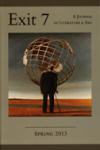Exit 7 – Spring 2013
Published by faculty members and students of West Kentucky Community and Technical College, the Spring 2013 issue of Exit 7 features fiction, nonfiction, poetry, and art originating from a wide range of geographical and stylistic traditions. The volume is slim and handsome, bookended by images of paintings by Bo Bartlett, whose work is also showcased in the middle of the journal.
Published by faculty members and students of West Kentucky Community and Technical College, the Spring 2013 issue of Exit 7 features fiction, nonfiction, poetry, and art originating from a wide range of geographical and stylistic traditions. The volume is slim and handsome, bookended by images of paintings by Bo Bartlett, whose work is also showcased in the middle of the journal.
In an introductory note to the art collection, Tom Butler describes Bartlett as “an American realist with a modernist vision.” The paintings are indeed extremely realistic; the subjects are depicted in a style that brings to mind a blending of Norman Rockwell and Rembrandt. These “all-American” scenes are brought to life with a shrewd use of light that guides the eye. Bartlett diverges from reality or exaggerates it to make important statements about contemporary society. In “Old Glory,” a little girl draped in an American flag wears the bright hint of a halo. Bartlett’s work seems like a great counter argument to friends who think that contemporary art consists solely of mid-gallery toilet seats and light-switch-or-artwork experimentation.
Who among us can say that they don’t enjoy biographical poetry about Charles Babbage, the nineteenth-century thinker whose ideas contributed to the development of modern computing? Neal Aitken addresses two poems to Babbage that are related to times during which Babbage fell in love and when he toured Mount Vesuvius. The geniuses among us may see the world in ways the rest of us simply can’t grasp, but they are still human. Aitken points out that Babbage may have had an unparalleled understanding of mathematics and science: “For you, the world has always been knowable. An endless stream of equations / expanding or contracting around an idea, a description of natural forces.”
In the end, Babbage is still as “unsteady” and as “uncertain” as the rest of us when it comes to romance.
Lynnell Edwards’s “Heron” is a short story about a middle-class family in the midst of some difficulties. Chase and Beth were not in agreement when he bought their new boat. The story is a slow burn; Edwards paints a portrait of the passive-aggressive way in which couples can sometimes deal with their problems. Chase and Beth may think they’re fighting about the boat, about allowing teenage daughter Meredith to have a bit of champagne, and about which of them is better suited to drive the truck at the boat launch, but they’re really clashing over much deeper issues. The story ends on a discordant note; the reader will enjoy imagining what happens in the white space that follows the final sentences.
Jay Hopler contributes four poems, two of them translated from the German. Hopler recasts the lines of Goethe and Rilke with a light touch and preserves the magic in the phrases of the originals. His own compositions employ a different style; “Le Due Sacre Famiglie” paints a beautiful picture of the sensory experience and feeling one might have in Rome’s Piazza Navona:
The late-October sun is setting
Through the high dome windows of the church of Saint Agnes
in
Agony,
Shafts of yellow-gold-orange light sweeping slowly across the
marble floors,
The columns of pink
Marble.
Exit 7 has a lot going for it; this issue boasts an august list of contributors and its poetry editors have eclectic taste. With only two issues behind them, the Exit 7 team shows great potential for their third and beyond.
[westkentucky.kctcs.edu/en/Student_Life/Exit7.aspx]





